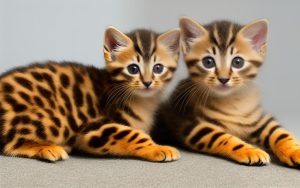Bengal Cat Breed Facts and History
Introduction
If the idea of having a miniature leopard as a companion intrigues you, then the Bengal cat might be your perfect match. Bred to embody the stunning appearance of a wild leopard combined with the charming nature of a domesticated house cat, Bengals have captivated cat enthusiasts worldwide. Let’s dive into the history, appearance, health, personality, and some fun facts about this unique feline breed.
The History of Bengal Cats
Originating as a hybrid breed, Bengals have a rich history dating back to the early 1900s. Breeders embarked on a pioneering journey, crossing domestic felines with Asian leopard cats, known scientifically as Felis bengalensis. These wild cats, native to Southeast Asia, are distinguished by their slender build and untamed appearance.
The breed as we know it today took shape in the 1970s when Jean Sugden Mill selectively bred Asian leopard cat hybrids with domestic cat breeds. Her vision was to create a feline that retained the exotic allure of the Asian leopard cat while embracing the amiable personality of a domestic cat. Bengal kittens today are several generations removed from their exotic ancestors, making them one of the most sought-after and expensive cat breeds.
Appearance of Bengals
Bengals are renowned for their striking jungle cat looks and distinctive markings. Their muscular bodies, long hind legs, sleek coats, and round-tipped ears reflect the influence of their wild ancestors. While the leopard-like appearance is a hallmark trait, Bengals display variations in coat color and eye color.
Coat Color: Bengals boast soft, sleek, and easily groomed coats with spotted or marbled patterns. Standard colors include brown, snow, and silver, while non-standard hues encompass charcoal, blue, and melanistic (solid black). Some Bengals even exhibit glittery coats, creating a shimmering effect.
Eye Color: Characterized by almond-shaped eyes, Bengals can showcase a range of shades, including hazel, brown, green, gold, or copper. Snow Bengals may have blue, blue-green, or aqua-colored eyes.
Biology & Health
Generally robust, Bengals may encounter specific health issues, including distal neuropathy, flat-chested kitten syndrome, hip dysplasia, hypertrophic cardiomyopathy, patellar luxation, and progressive retinal atrophy. Despite these concerns, maintaining a healthy diet and regular veterinary check-ups contribute to their well-being.
Weight Range: Bengals, though appearing larger due to their long and muscular build, are a medium-sized breed. Females can weigh as little as 6 lbs., while males may reach around 15 lbs. High energy levels often help Bengals maintain a healthy weight through calorie burning.
Life Expectancy: Bengal cats typically enjoy a lifespan of 10 to 16 years, influenced by factors such as overall health and whether they are indoor or outdoor cats.
Personality
Contrary to their wild appearance, Bengal cats are affectionate and friendly. Known for their loyalty to their human companions, they exhibit high intelligence and can even be trained to perform tricks. Their strong, athletic bodies and boundless energy make them adept climbers, and they are often fond of water activities. Providing mental and physical stimulation is essential for a happy Bengal.
Fun Facts About Bengal Cats
- Bengals are highly intelligent and can be trained for intricate tricks, showcasing their problem-solving skills.
- Their glittery coats result from translucent hollow hair that reflects light, creating a sparkling effect.
- Bengals are not completely hypoallergenic, but their minimal shedding reduces allergic reactions.
- Social and active, Bengals are ideal for families with children and cat-friendly dogs.
Frequently Asked Questions
- Are Bengal cats hypoallergenic?
- While no cat is completely hypoallergenic, Bengals shed less than other breeds, minimizing allergic effects.
- Do Bengal cats get along with children and other pets?
- Bengals are known for their social and active nature, making them a great choice for families with children and cat-friendly dogs. Caution is advised with smaller pets that could be perceived as prey.
Conclusion
The Bengal cat, with its intriguing history, captivating appearance, robust health, and delightful personality, stands as a unique and cherished companion for feline enthusiasts. Whether you’re drawn to their leopard-like beauty or their playful antics, Bengals are a breed that brings joy and fascination to any household.

